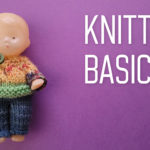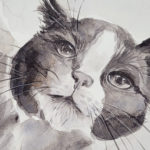Vor einiger Zeit schon wurde mir gesagt, dass ich “seltsam” stricke. Allerdings scheint es sehr schnell und effizient zu sein, daher teile ich mit euch meine Stricktechnik und wie ich die Nadeln und das Garn halte.
Obwohl ich im Video nur die Grundschritte zeige, ist das Stricken für mich eine super Entspannungsmethode geworden. Angefangen habe ich vor ca. 17 Jahren und in dieser Zeit schon etliches gestrickt.
Wo finde ich Anleitungen?
Viele Anleitungen finde ich auf Ravelry und habe auch selbst schon einige Strickanleitungen verfasst.
Für das Püppchen, das für mich hohen sentimentalen Wert hat, habe ich erst diese Woche spontan ein Outfit gestrickt. Ganz ohne Anleitung.

Tipps für den Anfang
Falls du mit dem Stricken beginnen willst, habe ich einen ganz großen Tipp für dich: Wähle ein Projekt, das dich interessiert. Es muss nicht das einfachste sein. Und vielleicht wird es etwas dauern und du musst zwischendurch mal nachschlagen. Aber wenn es etwas ist, das du gerne haben und machen möchtest, dann verlierst du auch nicht so schnell das Interesse daran. Eine Freundin wählte Socken als ihr erstes Projekt und die sind wirklich nicht ganz einfach zu stricken. Sie hat es übrigens geschafft!
Guidelines zur Wahl deiner Garne und Nadeln
Als Material empfehle ich zum Anfang ein Garn, das eine Nadelstärke von 3,5-4,5 braucht. Weil du damit das Halten der Nadeln am Besten üben kannst. Dünnere Garne sind auch möglich (nicht unter 2,5) und dickere auch, allerdings wird es da schwierig, weil die Nadeln sehr dick werden. Und eben entsprechende Nadeln. Nadelspiel, wenn du kleinere Sachen in der Runde stricken willst (z.B: Socken, Mützen, Fäustlinge etc.) oder Rundstricknadeln für flache Sachen (z.B. Schal, Tuch) oder große Runden (z.B. Pulli). Die langen einfachen Nadeln würde ich nicht empfehlen, da beim Stricken die Gewichtsverteilung nicht optimal ist und es beim Lernen hindert.
Meine persönlichen Stricknadel-Empfehlungen auf lange Sicht
Meine Liebsten sind Sets von Nadelspielen und Rundstricknadeln von KnitPro aus Holz und aus Aluminium, allerdings gibt es die auch von Prym, die auch eine gute Qualität haben. Meine Schwester hat die von Prym und ist begeistert. Für den Anfang aber reichen zwei Nadeln für dein jeweiliges Projekt.
Zudem brauchst du noch eine Nähnadel, eventuell eine Häkelnadel und eine Schere sowie das Garn. Auf dem Label des Garns siehst du übrigens auch die empfohlene Nadelstärke. Richte dich da nach dem Mittelwert.
Die Empfehlungen kommen nun durch meine (eingeschränkte) persönliche Erfahrung, es gibt noch viele andere tolle Hersteller. Mit meinen Sets bin ich aber voll bedient und brauche nichts anderes mehr – vermutlich auf Lebenszeit.
Gestalte dein Leben bunt. 🙂
Lana
A while ago I was told, that I’m knitting “in a weird way”. But it’s also quick and efficient, so I made a video sharing my knitting style and how I hold the yarn and needles.
Although I’m showing only the basic stitches in the video, knitting is one of the best methods for me to relax. I started about 17 years ago and have knitted lots and lots over the last years.
Where do I find my patterns?
Most of the patterns I use I found on Ravelry, where I have also published some myself.
For the doll, which has a high sentimental value for me, I knitted a little outfit spontaneously. Without any patterns.
Tips to begin knitting
If you want to start knitting, here are some tips for the beginning: Choose a project you feel passionate about. It doesn’t have to be the simplest one, but also not the most complicated one. It might be tough at times and you have to look up how certain things go, but in the end you’ll make something you want to have. It helps to stay motivated and you won’t loose interest as quickly. A friend of mine started out with socks and it’s really not the simplest thing to start with. And she did so well knitting them!
Some guidelines for your first needles and yarns
For the beginning I’d suggest getting a yarn, that needs size 3,5-4,5mm needles. Those will be easiest to learn holding the needles and getting used to the movement. Thinner needles will go too, but aren’t as simple. I’d suggest not to go below 2,5mm and not thicker than 5,5mm because the thick needles are not as simple to hold and you won’t get used to the proper movement. Get double point needles in the right size of your yarn if you intend to knit smaller round knit projects (socks, hats, mittens etc.) or circular needles if you want to knit flats or big rounds (scarf, shawl, cardigan, pullover). I would suggest to not buy the long needles as the weight distribution during knitting is not ideal and it’s difficult to learn on those.
My personal suggestions for knitting needle sets for the long run
My favourite sets of double point needles and circular needles are made by KnitPro from wood but also the aluminium ones. My sister has those made by Prym, which are great too. She uses them for several years now and is happy with them. For a start you don’t need the full set but just the needles for your project.
You might also need a needle to weave in ends, maybe a crochet hook, scissors and yarn. On the label of the yarn you can btw. see which size needles and hook you would need.
All the suggestions come from my (limited) expertise – I didn’t try all the brands out there. But I’m very happy with the ones I have and I don’t feel like I need any more than I own now.
Time to make your life colorful. 🙂
Lana
Disclaimer: Affiliate Links verwendet für die Artikel auf amazon. / I used affiliate links for the articles on amazon.







Neueste Kommentare